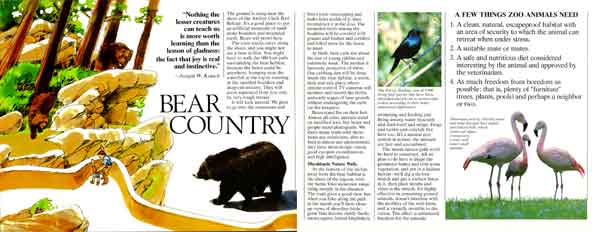| |

|
Welcome to Our Dream |
The Purpose of the Zoo |
Tour our New Zoo |
Board the Train at the Community Building |
SIDEBAR:
"Nothing the lesser creatures can teach us is more worth learning than the lesson of gladness: the fact that joy is real and instinctive. "-Joseph W. Krutch
BEAR COUNTRYThe ground is steep near the shore of the Andree Clark Bird Refuge. It's a good place to put an artificial mountain of sandstone boulders and mounded earth. Bears will prowl here. The train tracks curve along the shore, and you might not see a bear at first. You might have to walk the 600-foot path surrounding the bear habitat, because the bears could be anywhere, lounging near the waterfall at the top or roaming in the tumbled boulders and deep-cut streams. They will seem separated from you only by very rough terrain. It will look natural. We plan to go into the mountains and find a natural rock outcropping and make latex molds of it, then reconstruct it in the Zoo. The mounded earth among the boulders will be covered with grasses and bushes and conifers and felled trees for the bears to maul. At birth, bear cubs are about the size of young rabbits and extremely weak. The mother is furiously protective of them. Our cubbing den will be deep inside the bear habitat, a warm, dark and safe place where remote-control TV cameras will monitor and record the births and early stages of bear growth without endangering the cubs (or the keepers). Bears stand flat on their feet. Almost all other animals stand on modified toes, but bears and people stand plantigrade. We share many traits with them: bears are omnivores, able to feed in almost any environment; they have stereoscopic vision, good eye-paw co-ordination, and high intelligence. Marshlands Nature Walk. At the bottom of the incline away from the bear habitat is the shore of the lagoon, with the Santa Ynez mountain range rising steeply in the distance. The train gives a good view, but when you hike along the path in the marsh you'll have closeup views of shoreline birds: great blue herons, ruddy ducks. snowy egrets, belted kingfishers, swimming and feeding and flying among water hyacinth and duckweed and sedge. Frogs and turtles and crayfish live here too. It's a natural ecosystem in action; the animals are free and unconfined. The marsh nature path won't be hard to construct. All we plan to do here is shape the perimeter banks and trim some vegetation, and put in a hidden barrier: we'll dig a six-foot trench and put a six-foot fence in it, then plant shrubs and vines in the trench. It's highly effective in containing ground animals, doesn't interfere with the mobility of the wild birds, and is virtually invisible to the visitor. The effect is unfettered freedom for the animals. CAPTION:The Glossy Starling: one of 9,000 living bird species that have been identified and categorized in twenty-eight orders according to their many anatomical differences. SIDEBARA FEW THINGS ZOO ANIMALS NEED 1. A clean, natural, escapeproof habitat with an area of security to which the animal can retreat when under stress. 2. A suitable mate or mates. 3. A safe and nutritious diet considered interesting by the animal and approved by the veterinarian. 4. As much freedom from boredom as possible: that is, plenty of "furniture" (trees, plants, pools) and perhaps a neighbor or two. CAPTION:Flamingos feed by filtering water and mud through their highly specialized bills, which strain out algae, crustaceans, worms, and other small animals. |